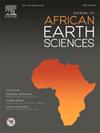伊朗西Sabzevar Bashtin地区碱性玄武岩的矿物学和全岩地球化学:地幔源变化的意义
IF 2.2
4区 地球科学
Q2 GEOSCIENCES, MULTIDISCIPLINARY
引用次数: 0
摘要
本研究考察了Sabzevar山脉西部Bashtin地区的碰撞后碱性玄武岩,重点研究了它们的全岩石地球化学和矿物组成。碱性玄武岩可分为两组熔岩玄武岩和一组哺育岩玄武岩,后者受结晶聚集作用的影响。组2玄武岩的FCKANTMS (>0.3)、FCMS(0.45-0.60)和Mn/Fe(72-80)值显著高于组1,组1玄武岩的FCKANTMS (> 0.035)、FCMS(0.02-0.28)和Mn/Fe(42-61)值均低于组1。相反,组1玄武岩的Co/Fe(3.3 ~ 5.9)、Ni/Co(5.3 ~ 6.7)、Mn/Zn(14 ~ 18)比值高于组2 (Co/Fe 2.6 ~ 2.9、Ni/Co 1.5 ~ 3.7、Mn/Zn 6 ~ 6.5)。这些地球化学差异表明,第1组烃源岩以橄榄岩为主,而第2组烃源岩岩性以辉石岩为主。采用电子探针微量分析(EPMA)和激光烧蚀电感耦合等离子体质谱(LA-ICP-MS)对矿物成分进行分析。在组1中,橄榄石晶体的MgO、MnO和SiO2含量高于组2,而FeO和NiO含量低于组2。与LaN/YbN(2.3 ~ 3.0)、MREE/HREE(3.8 ~ 4.6)和LREE/HREE(10.4 ~ 13)的组1相比,组2斜辉石岩的REE分异程度更高,LaN/YbN (3.5 ~ 17.4), LREE/HREE(17.2 ~ 47)和MREE/HREE(6.2 ~ 7.8)。虽然给料岩脉的整体组成不能直接反映液体组成,但矿物组成表明,原始岩浆可能起源于辉石岩为主的来源,这强调了矿物地球化学在评估基性岩起源中的重要性,特别是堆积岩,其中整个岩石组成不能代表原始岩浆。本文章由计算机程序翻译,如有差异,请以英文原文为准。
Mineralogy and whole-rock geochemistry of alkali basalts from the Bashtin area, west Sabzevar, Iran: Implications for mantle source variations
This study examines post-collisional alkali basalts in the Bashtin area, west of the Sabzevar Range, focusing on their whole-rock geochemistry and mineral composition. The alkali basalts are classified into three groups: two lava groups and one group of feeder dyke basalts, the latter affected by crystal accumulation processes. Group 2 basalts show significantly elevated values of FCKANTMS (>0.3), FCMS (0.45–0.60), and Mn/Fe (72–80) compared to group 1, which has lower values for these parameters (FCKANTMS <0.035, FCMS 0.02–0.28, and Mn/Fe 42–61). Conversely, group 1 basalts display higher Co/Fe (3.3–5.9), Ni/Co (5.3–6.7), and Mn/Zn (14–18) ratios than group 2 (Co/Fe 2.6–2.9, Ni/Co 1.5–3.7, and Mn/Zn 6–6.5). These geochemical differences suggest that group 1 arises from a peridotite-dominated source, while group 2 derives from a pyroxenite-dominated lithology.
Mineral compositions were analyzed using Electron Probe Microanalysis (EPMA) and Laser Ablation Inductively Coupled Plasma Mass Spectrometry (LA-ICP-MS). In group 1, olivine crystals contain higher MgO, MnO, and SiO2 but lower FeO and NiO than those in group 2. The clinopyroxenes in group 2 exhibited a more fractionated REE pattern, with LaN/YbN (3.5–17.4) and higher LREE/HREE (17.2–47) and MREE/HREE (6.2–7.8) ratios than those in group 1, which had LaN/YbN (2.3–3.0), MREE/HREE (3.8–4.6), and LREE/HREE (10.4–13). Although the feeder dyke's overall composition does not directly reflect the liquid composition, minerals composition suggest that the primary magma likely originated from a pyroxenite-dominated source, underscoring the importance of mineral geochemistry in assessing the origins of mafic rocks, particularly cumulates, where whole-rock compositions are not representative of the primary magma.
求助全文
通过发布文献求助,成功后即可免费获取论文全文。
去求助
来源期刊

Journal of African Earth Sciences
地学-地球科学综合
CiteScore
4.70
自引率
4.30%
发文量
240
审稿时长
12 months
期刊介绍:
The Journal of African Earth Sciences sees itself as the prime geological journal for all aspects of the Earth Sciences about the African plate. Papers dealing with peripheral areas are welcome if they demonstrate a tight link with Africa.
The Journal publishes high quality, peer-reviewed scientific papers. It is devoted primarily to research papers but short communications relating to new developments of broad interest, reviews and book reviews will also be considered. Papers must have international appeal and should present work of more regional than local significance and dealing with well identified and justified scientific questions. Specialised technical papers, analytical or exploration reports must be avoided. Papers on applied geology should preferably be linked to such core disciplines and must be addressed to a more general geoscientific audience.
 求助内容:
求助内容: 应助结果提醒方式:
应助结果提醒方式:


